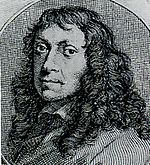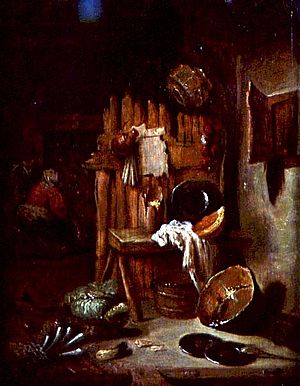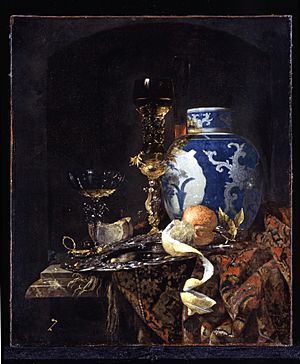Willem Kalf facts for kids
Quick facts for kids
Willem Kalf
|
|
|---|---|
 |
|
| Born | 1619 |
| Died | 31 July 1693 (aged 73–74) Amsterdam, Netherlands
|
| Known for | Still-life paintings |
| Movement | Dutch Golden age |
Willem Kalf (1619 – 31 July 1693) was a very important Dutch still-life painter in the 17th century. This time was known as the Dutch Golden Age, a period when the Netherlands was very rich and powerful.
Willem Kalf was well-known and respected during his own lifetime. People admired his deep knowledge of art and his friendly personality. Today, he is most famous for his later still-life paintings, called pronkstilleven in Dutch. These paintings show beautiful and expensive objects from around the world. One famous example is his painting Still life with nautilus beaker and porcelain lidded bowl from 1662. It has become a very famous piece of Western art.
Contents
Willem Kalf's Life Story
We don't know a lot about Willem Kalf's life because there aren't many direct writings about him. Most of what we know comes from old records and documents. These records connect him to different times, places, and people.
Early Years and Family
Willem Kalf was born in Rotterdam in 1619. He was baptized in the Saint Lawrence church that same year. His father, Jan Jansz. Kalf, was a rich cloth merchant and a member of the Rotterdam city council. Willem was only six years old when his father passed away in 1625.
Willem stayed in Rotterdam with his mother. He started showing interest in painting when he was about 18 years old. His mother died in 1638. After that, Willem left his hometown and moved to The Hague. Around 1641, he moved to Paris, France.
Time in Paris
After learning to paint in the Netherlands, Willem Kalf moved to Paris around 1641. He joined a group of Flemish artists there. He likely stayed in Paris until the autumn of 1646. During this time, he mostly painted French interiors, like small kitchens and barns. This period is often called his French or Parisian period.
We know Kalf was in Paris from stories written by Nicolaas Vleugels. Nicolaas wrote about his father's first meeting with Kalf and other artists. They lived in a house called La Chasse, which was a "refuge for painters from his country." Nicolaas mentioned Kalf among other skilled painters there.
Kalf's paintings of farm interiors were very popular. Other artists often copied them, even into the 18th century. Famous painters like Chardin and François Boucher owned Kalf's paintings. Some even reworked them. For example, Boucher bought Kalf's Interior of a rustic kitchen (1642-1643), which is now in the Louvre museum.
While in Paris, Kalf also started a new type of painting: his still-life works. These paintings quickly became popular in France and beyond.
Moving Back to the Netherlands
In October 1646, Kalf returned to Rotterdam. But he didn't stay there long. Five years later, in 1651, he got married in the city of Hoorn. The marriage book shows that Willem Janszoon Kalf from Rotterdam married Cornelia Pluvier. Cornelia was a talented poet, calligrapher, and glass engraver. Her skills even caught the eye of Constantijn Huygens, a famous Dutch statesman.
It's a bit surprising that Kalf settled in Hoorn, as there weren't many other well-known painters there. Soon after their marriage, Willem and Cornelia moved to Amsterdam. They had four children there. Willem Kalf lived in Amsterdam until he died in 1693.
Final Years in Amsterdam
By 1653, Willem Kalf was living in Amsterdam. In 1654, he became a member of the Saint Luke's Guild in Amsterdam. This was a group for artists.
Amsterdam was a busy city for art at that time. It was full of painters, art dealers, and buyers. Kalf likely met many art dealers there. He had already met some in Paris, like Picart. Kalf even introduced other artists to these dealers.
Willem Kalf was also known for being an art expert. He helped decide if paintings were real or not. For example, in 1653, he helped check a painting by Paul Brit. In 1686, he gave his expert opinion on a painting thought to be by Titian. This suggests he might have been an art dealer himself.
In Amsterdam, Kalf began his most famous period, painting pronkstilleven (fancy still lifes). Some people think he got his collection of expensive and exotic objects for his paintings from his art dealing. Even though these paintings are now seen as his best work, he painted very few of them. It's even thought that he stopped painting completely after 1680. His last known still life is Still life with Holbein bowl and silver ewer.
Willem Kalf died on July 31, 1693. A story says he went to an art sale and then visited a friend. On his way home, he tripped and was badly hurt. He made it home but passed away that night.
Willem Kalf's Art Style
Early French Period (1638-1646)
In Paris, Kalf mostly painted small scenes of rustic interiors and still lifes. His rustic interiors often show groups of vegetables, buckets, and pots arranged in the front of the painting. These paintings look different from Dutch art because of certain vegetables, like garlic and pumpkin, and the type of canvas used.
People usually appear only as blurry shapes in the background of these paintings. Even though they were painted in Paris, these pictures are similar to a style popular in Flanders in the early 17th century.
During the 1640s, Kalf also developed a new kind of still life. He created rich and fancy still lifes, known as pronkstilleven, showing beautiful gold and silver items.
Mature Period (1650s onwards)
In his most famous later works, painted in Amsterdam, Kalf focused on a few special objects. He carefully placed these items against a dark background. Often, a fancy damask cloth or tapestry is draped on a table. On the table, you can see tableware, gold, and silver items. Many of these have been identified as works by specific goldsmiths.
His paintings almost always include Venetian-style goblets and a Chinese porcelain bowl from the Wanli period of the Ming Dynasty. This bowl is often tilted, with half-peeled citrus fruits spilling out.
Instead of showing Dutch cheeses or baked goods, Kalf used items imported from different parts of the world. These were meant to appeal to rich citizens who had gained wealth from trade in the Dutch Republic.
Like many still lifes from this time, the delicate and luxurious items in Kalf's paintings could be seen as vanitas elements. Vanitas paintings remind people that life is short and worldly goods are temporary. However, some art experts believe Kalf's main goal was simply to create a beautiful arrangement of luxurious items. So, the vanitas meaning might have been a side effect, not his main purpose.
Influence on Other Artists
It's believed that the artist Frans Rijckhals influenced Kalf's early French period works. This is because their colors and styles are similar. Another artist, Cornelis Saftleven, might have also influenced Kalf's interior paintings.
Kalf's rustic interiors from his French period had a big impact on French art, especially on the Le Nain brothers. The still lifes Kalf created in Paris also connect to the "little banquet pieces" painted by Dutch artists like Pieter Claesz and Willem Claeszoon Heda.
We don't know much about Kalf's art workshop or if he had official students. However, some copies of his work suggest he had assistants in his later years in Amsterdam. Kalf's way of painting highlights has often been compared to that of Johannes Vermeer. Some even think Vermeer was influenced by Kalf. Among those who followed Kalf's style, Juriaen van Streeck was the most successful.
Willem Kalf's Popularity
Many art galleries and museums have shown Willem Kalf's work in exhibitions. His paintings have also been sold at auctions many times. Some have sold for very high prices. For example, in 2019, a still-life painting by Kalf sold for US$2,775,000 at Christie's New York. This painting, titled A chafing dish, two pilgrims’ canteens, a silver-gilt ewer, a plate, and other tableware on a partially draped table, is one of only 13 known still lifes from Kalf's French period.
Museums with Willem Kalf's Art
- Museum Boijmans Van Beuningen, Rotterdam
- Museum de Fundatie, Zwolle
- Mauritshuis, The Hague
- National Gallery of Art, Washington
- Rijksmuseum Amsterdam
- Staatliche Kunsthalle Karlsruhe, Karlsruhe
- Statens Museum for Kunst, Copenhagen
- Suermondt-Ludwig-Museum, Aachen
- The Metropolitan Museum of Art, New York
- The J. Paul Getty Museum, Los Angeles
- Thyssen-Bornemisza National Museum, Madrid
Exhibitions Featuring Willem Kalf
- Willem Kalf 1619–1693, November 25, 2006 - February 18, 2007, Museum Boijmans Van Beuningen.
- Painted light: the still-life paintings of Willem Kalf, March 8 - June 3, 2007, Suermondt-Ludwig Museum.
- Schonheit und verganglichkeit - Niederlandische stilleben aus dem Staatlichen museum Schwerin, December 6, 2007 - February 17, 2008, Kunstforum der Berliner Volksbank, Berlin.
- The magic of things, March 20 - August 17, 2008, Städel Museum, Frankfurt.
- The magic of things, September 5, 2008 - January 4, 2009, Kunstmuseum Basel, Basel.
Images for kids
See also
 In Spanish: Willem Kalf para niños
In Spanish: Willem Kalf para niños





